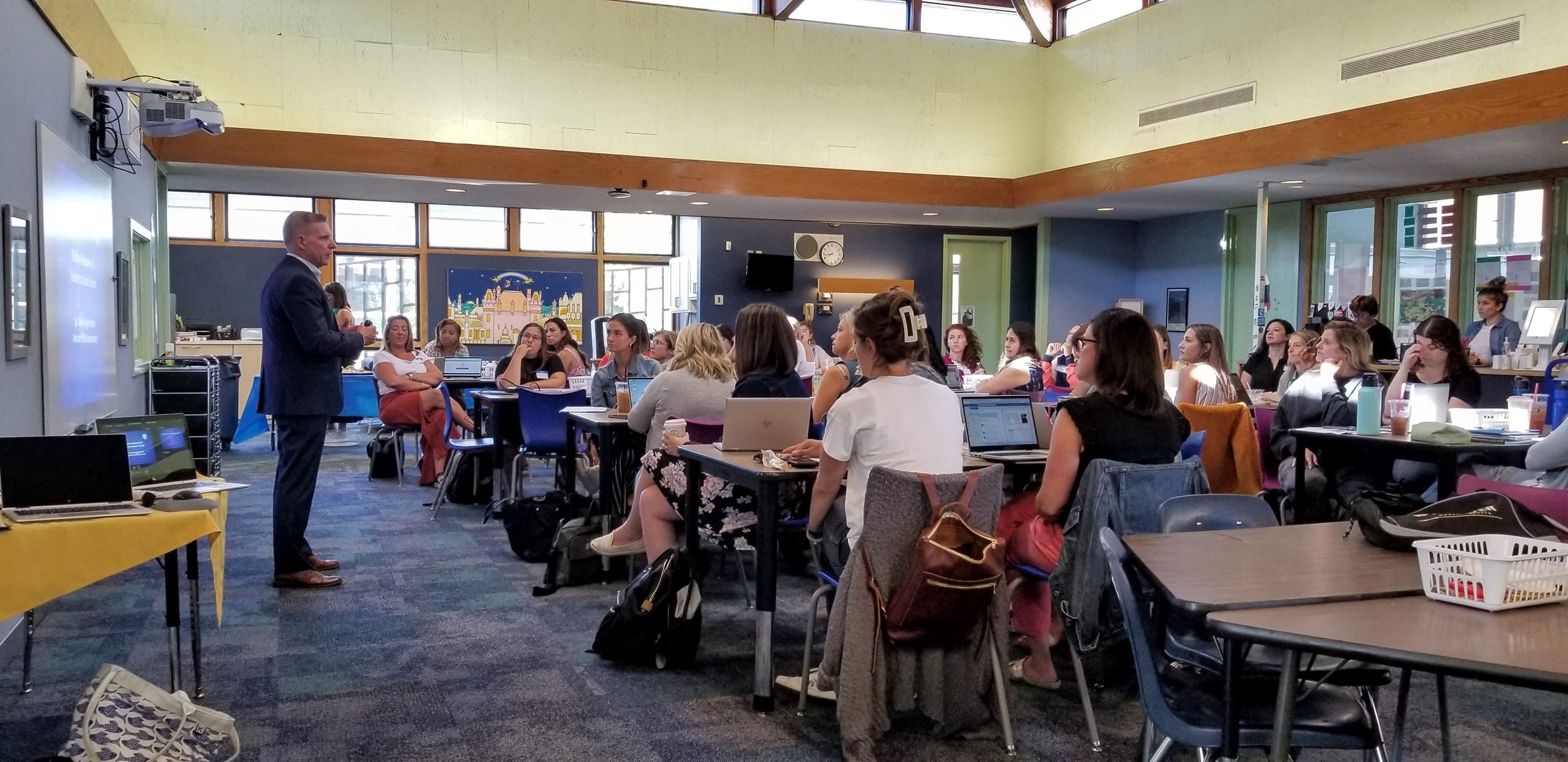Evacuation will take place if it is determined to be safer outside the building and staff, students, and visitors can safely reach an evacuation location without danger. Reverse evacuation should occur when conditions are safer inside the building than outside, generally when conditions involve severe weather, community emergencies, or hazardous material release outside of the building.
School Safety at APS
Introduction
Dear APS staff and families,
The Andover Public Schools and the Andover Police Department have a shared goal of keeping students and staff safe during the school day. Through ongoing conversations, we always seek opportunities to foster improved partnership between APD and APS and the timeliness of the communications shared with our community. Together, we strive for continuous training, collaboration, and coordination to maintain secure environments at our schools.
The security of our students and staff is a shared responsibility. The community’s partnership and role in the response is critical to ensuring our staff and students’ safety. We encourage our families, staff, and students to share with administrators immediately if something appears unusual or suspicious. Sharing what you observe can make a difference.
Each school within the district has an emergency response plan and response team identified specifically to their building. These plans detail possible scenarios and how to respond and work with first responders accordingly.
In the instance of a crisis, families and staff will receive information from APS as it develops through text messages, emails and voicemail. We aim to be as forthcoming and accurate as possible with confirmed information we know at the time. We encourage our families to speak with their children about the importance of always following the guidance of APS staff to ensure their safety.
We recognize the trust families place in APS and APD when sending your children to school. We appreciate your partnership and cooperation.
Dr. Magda Parvey, Superintendent, Andover Public Schools
Chief Patrick Keefe, Andover Police Department
Key Safety Terms
We would like to offer clarity on how best to ensure our emergency operations and planning can be implemented if a situation arises. Should families receive a message from their school during a possible crisis, we wanted to provide clear definitions of terms and guidance on how best to support the district, our schools, and first responders. Every situation is different; these are overall guidelines.
Evacuation and Reverse Evacuation
Lockdown
Lockdown is the initial physical response to provide a time barrier during an active event that threatens student and staff safety. Lockdown is not a stand-alone defensive strategy and is a key component of the A.L.I.C.E. response training program (see below for information on A.L.I.C.E). This lockdown procedure should involve students and staff staying wherever they are located and readying a plan for evacuation or counter tactics should the need arise. Lockdown provides safe areas for students, guests, and faculty within the building during an incident. Safe areas may change depending on the nature of the emergency.
A lockdown announcement will result in law enforcement and other safety and emergency services responding to the scene. It is critical to follow the instructions of and cooperate with the law enforcement officers for the safety of all on campus.
Hold
When a school administrator calls for a hold, movements by students and staff should be limited while dealing with a short-term emergency. In certain situations, and as determined by administration and/or public safety, students and staff may be permitted to move around inside the school. There should be no exit from or entry into the building.
Holds can be issued for a variety of reasons including medical emergencies, maintenance issues, or a student who may need individualized support and privacy or to manage an incident that does not place the school community in danger. Holds can include an incident that is occurring outside of the school, such as police activity near the school building, a weather event, power outage, a chemical spill, HAZ-MAT incident, or by order of a public safety official.
What should families do in case of an emergency? Do's and Don'ts
Do prepare your child:
We certainly don’t want to scare our children more than the world already can, but it is still important to prepare them for these potential situations. Explain how they will be expected to behave and that they may not be able to talk to you right away. We ask that you stress that they should listen to their teachers and those in uniform (emergency personnel) who are there to help.
Don’t call or go to the school:
If a school has sent out a crisis notification, it may involve an unsafe environment surrounding the school. School staff will most likely be unable to answer phones and the lines must remain clear to contact emergency personnel. For your safety, the safety of your child, and the well-being of all involved, it’s best to steer clear until you get the okay from the school. Further, if police have to worry about crowd management due to parents arriving on scene, their attention will be drawn away from addressing the situation.
Do have your ID with you:
If you are asked by the school or emergency personnel to pick your child up, make sure you have the proper ID. Even if you are well known to the staff, there may be other officials involved in the situation, and you should be prepared to prove your identity.
Don’t contact your child:
With the wide use of cell phones, getting in touch with your child at school is probably a snap. Whether by call or text, and despite your instinct, it is best NOT to try to get in touch with your child during these situations. Exchanging information with them, especially information that is incomplete or wrong, could make matters worse or cause unnecessary worry. In addition, ringing or beeping cell phones could compromise the safety of your child and others in a lockdown situation. Don’t use apps, such as Find My iPhone, because they can cause phones to emit sounds, even when the phone is in silent mode. APS has protocols in place that will keep you up to date on the situation and it is best to abide by those protocols.
Parent Information/Reunification Area:
In the event of a school emergency, parents may receive instructions from APS directing them to a parent information/reunification area. This will be an area designated away from the school where parents will be able to receive the most current and accurate information from school and police personnel. It is imperative that parents/family stay away from the school where the emergency is occurring unless otherwise directed. This will allow first responders to focus on resolving the emergency.
Don’t Panic:
This is probably the most important thing to remember. Of course, when we hear about a school having a crisis, we assume the worst. There are many reasons that a school can experience an emergency. Remain calm for both you and your child. If you hear that a school is in lockdown, know that police and other emergency services are likely already on scene at that time.
A.L.I.C.E. in Andover Public Schools
Alert: | Get the word out using clear concise language, describing the location of the event. |
Lockdown: | As a starting point, continue to lock down students in secure areas. |
Inform: | Keep staff and students informed, thereby allowing for good decision making. |
Counter: | Apply skills to barricade, and if necessary, distract, confuse and gain control. |
Evacuate: | Reduce the number of potential targets for the shooter, and reduce chances of injuries. |

In 2014, Andover’s Emergency Management working group adopted the enhanced A.L.I.C.E. procedures, offering age-appropriate options that will allow our students and teachers to be better prepared if a crisis situation occurs. It became apparent that both staff and students need options to help deal with a threat while that threat is occurring. All Massachusetts school districts are required to adopt one of the response training programs options. Andover has selected the A.L.I.C.E. program.
An important goal of the A.L.I.C.E. program is to evacuate to a safe place. It is also critical to note that A.L.I.C.E. is not a step by step drill, but students and staff should choose what strategy is best for their unique location and situation.
A.L.I.C.E. trainings are a coordinated effort with the Andover Police Department and APS. These trainings are led by Detective Mark Higginbottom from the Andover Police Department and Keith Taverna, Assistant Superintendent for Finance and Administration for Andover Public Schools and the school principals. All schools’ administrators also work in cooperation with school health representatives and the Andover Fire Department.
Drills are performed at all schools and for all age levels, and trainings are tailored to be age-appropriate. A.L.I.C.E. training is typically scheduled for the start of each school year, and include both announced and unannounced drills throughout the school year at all schools.
While the topic of safety can be uncomfortable to discuss with children, A.L.I.C.E. is designed to prepare students for emergencies, if they occur. Our elementary schools have developed a common theme for teaching younger children about drills- “Always Follow and Listen to Your Teacher!”
For more information on A.L.I.C.E., please watch Alice Training Video produced and offered by the Waltham Police and many questions can be answered on the A.L.I.C.E. Website.
